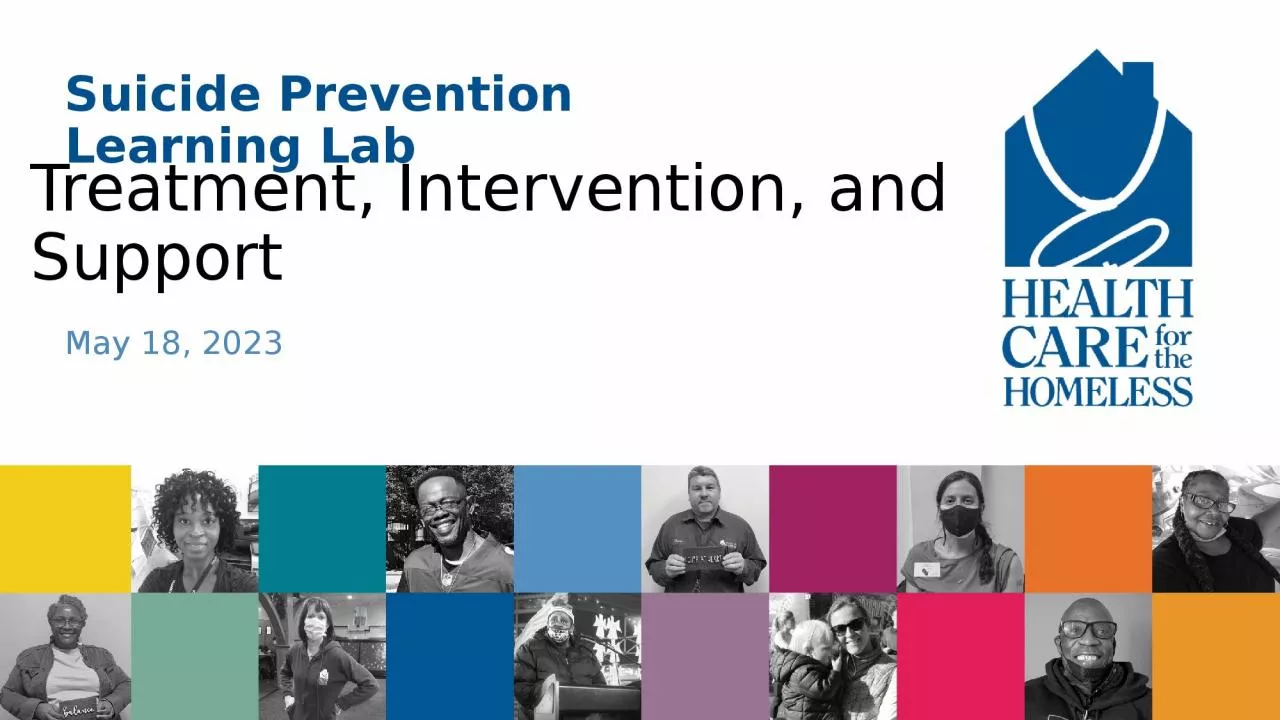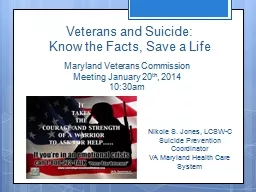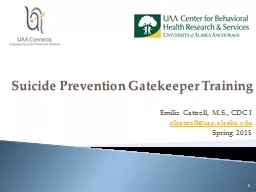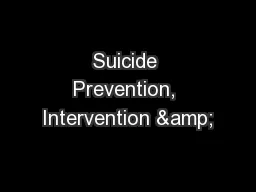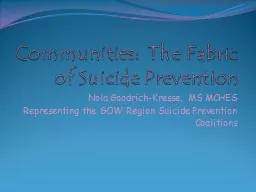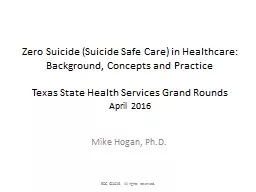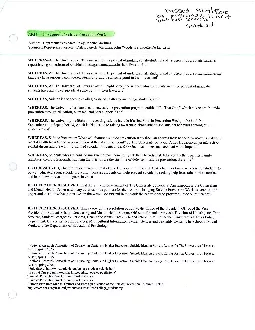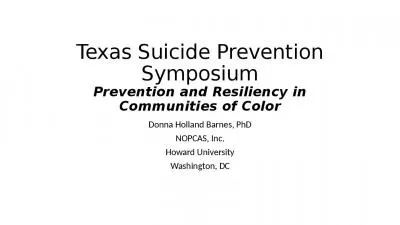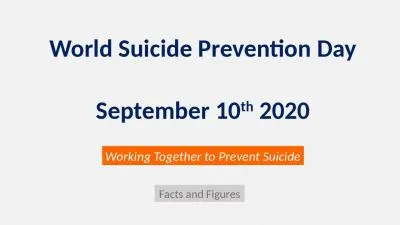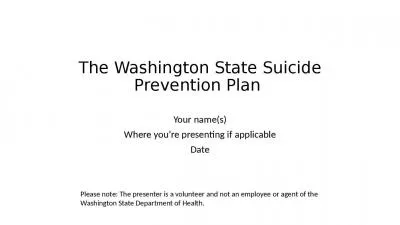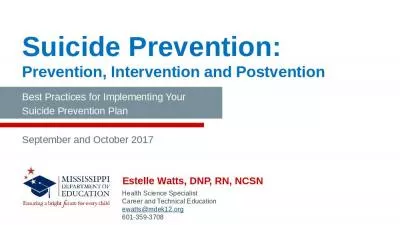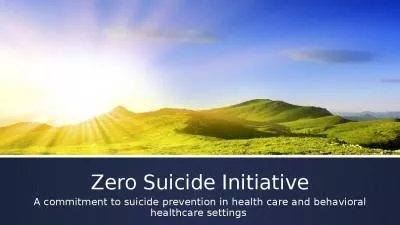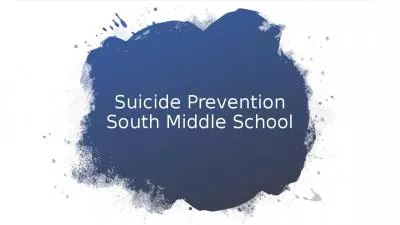PPT-Suicide Prevention Learning Lab
Author : murphy | Published Date : 2024-01-03
May 18 2023 Treatment Intervention and Support Learning Objectives Cultural Perspectives on Suicide Treatment Planning Common Interventions Supporting clients after
Presentation Embed Code
Download Presentation
Download Presentation The PPT/PDF document "Suicide Prevention Learning Lab" is the property of its rightful owner. Permission is granted to download and print the materials on this website for personal, non-commercial use only, and to display it on your personal computer provided you do not modify the materials and that you retain all copyright notices contained in the materials. By downloading content from our website, you accept the terms of this agreement.
Suicide Prevention Learning Lab: Transcript
May 18 2023 Treatment Intervention and Support Learning Objectives Cultural Perspectives on Suicide Treatment Planning Common Interventions Supporting clients after a suicide attempt Supporting providers as they support others. S Surgeon General and the National Action Alliance for Suicide Prevention Action Alliance The National Strategy is a call to action that is intended to guide suicide prevention actions in the United States over the next decade It outlin es four strat Know the Facts, Save a Life. Maryland Veterans Commission. Meeting January 20. th. , 2014. 10:30am. Nikole S. Jones, LCSW-C. Suicide Prevention Coordinator. VA Maryland Health Care System. About Me. Social Worker . Training. Emilie Cattrell, M.S., CDC I. elcattrell@uaa.alaska.edu. Spring 2015. 1. UAA Integrated Suicide Prevention Initiative. _______________________________________. The UAA-ISPI is a comprehensive, coordinated, culturally-sensitive effort aimed at promoting campus-wide suicide prevention education and awareness. Postvention. in Schools. An Overview for School Leaders. Suicide is a difficult topic…. Most of us have been touched, . professionally and/or personally, by suicide. Important to support one another as we approach this topic today….and in days following. Nola Goodrich-Kresse, MS MCHES. Representing the GOW Region Suicide Prevention Coalitions. Disclaimer…. All speakers, associated with this continuing education activity, have indicated that they have no financial arrangement or affiliation with any commercial entity whose products, research or services may be discussed in this presentation.. Background, Concepts and Practice. Texas State Health Services . Grand Rounds. April 2016. Mike Hogan, Ph.D.. EDC ©2016. All rights reserved.. Health Care Progress Measured by Death Rates. National Action Alliance for Suicide Prevention. Prevention g aPrevention g e20th e Sy we aPrevention k is aPrevention k ty id od MPrevention Week and their programming efforts and because they will host this important event the week of September 20 Prevention and . Resiliency in Communities of Color. Donna Holland Barnes, PhD. NOPCAS, Inc.. Howard University. Washington, DC. Agenda. Resiliency in the African American Communities – say what. ?????. September 10. th. 2020. Working Together to Prevent Suicide. Facts and Figures. Over. 800,000 . people die by suicide annually,. representing 1 person every 40 seconds. Suicide is the . 15th leading cause of death . Your name(s). Where you’re presenting if applicable. Date. Please note: The presenter is . a volunteer and not . an employee or agent of the Washington State Department of Health. . Introduction. Presenter intro. The International Association for Suicide Prevention (IASP) initiated World Suicide Prevention Day in 2003. The day is co-sponsored by the World Federation for Mental Health and World Health Organization. The aim of the day is to research and collect data on suicidal behavior, determine the various causes and why its signs go unnoticed, and developing sound practices and policies for suicide prevention. . Best Practices for Implementing Your Suicide Prevention Plan. September and October 2017. Estelle Watts, DNP, RN, NCSN. Health Science Specialist. Career and Technical Education. ewatts@mdek12.org. 601-359-3708. What is Zero Suicide?. Zero suicide is a key concept of the . 2012 National Strategy for Suicide Prevention. , a priority of the National Action Alliance for Suicide Prevention, a promoted project through SPRC, and supported by the Substance Abuse and Mental Health Services Administration (SAMHSA). Jamie's Law – Suicide Prevention Education. Jamie 's Law was named after a young man who killed himself. Since his passing, his sister is bringing awareness to the high risk of suicide among young adults..
Download Document
Here is the link to download the presentation.
"Suicide Prevention Learning Lab"The content belongs to its owner. You may download and print it for personal use, without modification, and keep all copyright notices. By downloading, you agree to these terms.
Related Documents

